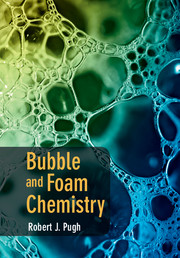Book contents
- Frontmatter
- Contents
- Preface
- Acknowledgments
- List of symbols
- 1 Basic principles and concepts
- 2 The nature and properties of foaming surfactants
- 3 Soap bubbles and thin films
- 4 Processes in foaming
- 5 Generation of bubbles and foams
- 6 Coalescence of bubbles in surfactant solutions
- 7 The stability/instability of bubbles and foams
- 8 Particle-stabilized foams
- 9 Foaming in non-aqueous liquids
- 10 Antifoaming and defoaming
- 11 Bubble size measurements and foam test methods
- 12 Bubble and foam chemistry - new areas of foam research
- Index
- References
3 - Soap bubbles and thin films
Published online by Cambridge University Press: 05 September 2016
- Frontmatter
- Contents
- Preface
- Acknowledgments
- List of symbols
- 1 Basic principles and concepts
- 2 The nature and properties of foaming surfactants
- 3 Soap bubbles and thin films
- 4 Processes in foaming
- 5 Generation of bubbles and foams
- 6 Coalescence of bubbles in surfactant solutions
- 7 The stability/instability of bubbles and foams
- 8 Particle-stabilized foams
- 9 Foaming in non-aqueous liquids
- 10 Antifoaming and defoaming
- 11 Bubble size measurements and foam test methods
- 12 Bubble and foam chemistry - new areas of foam research
- Index
- References
Summary
But all bubbles have a way of bursting or being inflated in the end.
Barry Gibbs, http://www.brainyquote.com/quotes/barrygibb199084.htmlIntroduction and early studies
Surfactants such as soap (sodium and potassium salts of fatty acids) stabilize thin liquid films, which are the basic structural units of foams and act as cell walls encapsulating the gas. The films are stabilized by surfactant monolayers of polar head groups (hydrophilic) solubilized in the water phase and aliphatic hydrocarbon tails (hydrophobic) protruding into the vapor phase. Isolated soap films can be easily produced by dipping a wire loop or rectangular frame into a soap solution and raising the frame slowly, causing the liquid to drain vertically. As the thickness of the film decreases from the top to the bottom of the frame, a pattern of interference fringes rapidly develops. This phenomenon can be spectacular, since each color band flows downward and a swirling motion is frequently observed due to rapid, complex fluid motion. Finally, toward the end of the thinning process, the film reaches a thickness that is less than the wavelength of light, and at this point, black spots appear, which spread rapidly, and eventually the entire film appears black in reflected light.
Foams, bubbles and foam films have been the subject of intense scientific investigations over a period of several hundred years. In the 17th century, both Robert Hooke (1) and later Isaac Newton (2) became captivated by these systems and carried out many fundamental experiments involving film drainage in bubbles in which the brilliant interference colors were carefully observed and reported in the Proceedings of the Royal Society. In Fig. 3.1, a typical spectrum generated by the drainage of thin foam films is illustrated.
It was also noted by scientists such as Newton and Hooke that, as the colored interference bands transformed to thin black films, the thinning ceased and eventually the films collapsed. This can be explained by the formation of a metastable state, resulting from the interaction of intermolecular forces. At first sight, the appearance of black spotswas extremely puzzling. Hooke first thought that these black spots were black holes in the soap bubbles, and Isaac Newton, in his second paper on light and color, described (as illustrated below) the occurrence of several different states of thickness of thin black films on bubble surfaces (as indicated by different shades of black and also the coalescence of the spots).
- Type
- Chapter
- Information
- Bubble and Foam Chemistry , pp. 84 - 111Publisher: Cambridge University PressPrint publication year: 2016



